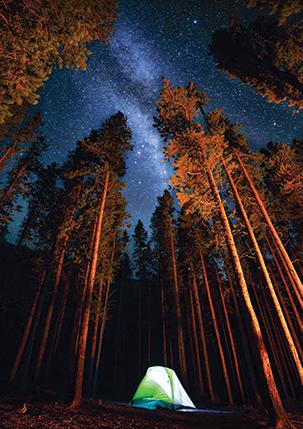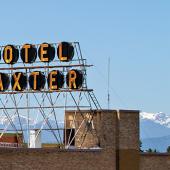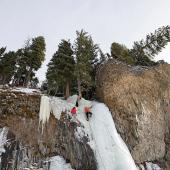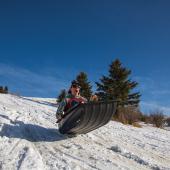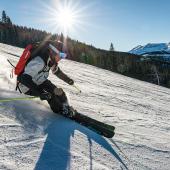Served Al Fresco
Spending a night under the stars.
With over 30 million acres of public land throughout Montana, you don’t have to go far to sleep outdoors. If you’re new to camping, spend a night car-camping at a developed site. These spots often have picnic tables, firepits, and toilets on location, which means all you have to do is get there and pitch your tent. Find (and reserve) developed sites in state parks, national parks, and national forests. Get started at recreation.gov. Backpacking into a campsite is more challenging, but can get you to some pretty spectacular spots.
What You’ll Need
Gearing up for an overnight camping trip is as simple as packing a shelter, a sleep system, clothes, and food. Car camping means you don’t have to worry about weight, whereas backpackers will want to aim for lighter options. Know how to pitch your tent before you get out there, and make sure you packed all the components—tent body, fly, stakes, and poles.
Your sleep system is comprised of a sleeping bag and sleeping pad, and sometimes a pillow. Know the forecasted lows for the area to avoid freezing. Your sleeping pad has an R-value, the rating for its insulating properties. Pay attention to the temperature rating of your sleeping bag, while keeping your own preferences in mind. For clothing, consider weather and the inevitable overnight temperature plummet. At the very least, bring a wicking baselayer top and bottom, a down or synthetic insulated jacket, a rain jacket, and a mid layer to ensure comfort at camp, regardless of the season.
Food is a personal preference. Some people go all out with a cookset and stove. Others stuff half a loaf of bread and a jar of peanut butter into the pack and call it good. Pack extra snacks to ensure you have adequate calories. For water, car campers can throw in a five-gallon jug and be set. Backpackers should carry a liter or two of water and know the on-site water sources. Bring treatment options such as a lightweight filter or purification drops.
Lastly, don’t forget a headlamp and extra batteries, a hat and gloves for chilly nights, and spare socks.
Safety Issues
No matter where you camp around Bozeman, you’ll be sharing the space with wildlife, whether you see them or not. Be bear aware, and always follow food-storage rules for the area. Never sleep with food in your tent, and learn how to hang a bear bag. Some developed campsites have bear lockers—use them.
Where to Go
Around southwest Montana, you can’t throw a rock without hitting BLM land, state parks, national forests, or wilderness areas. Hyalite has a plethora of camping options, both developed and undeveloped, and ample places to hike into for a night. Nearby state parks like Lewis & Clark and Missouri Headwaters have developed campsites for a small fee. We probably don’t have to say it, but steer clear of pitching the tent in town parks—that’s a good way to feel the long arm of the law.
Seasonal Considerations
New campers should stick to three-season excursions. Winter camping is an adventure unto itself, but takes increased preparation, special gear, and a separate skillset to make it safe. Summers here are often dry, and water sources can vanish by the end of the season. Summer also comes with increased fire danger—be sure to stay current on all regional fire restrictions. Shoulder seasons can offer prime camping conditions, but be prepared for unexpected temperature and weather fluctuations during spring and fall.


